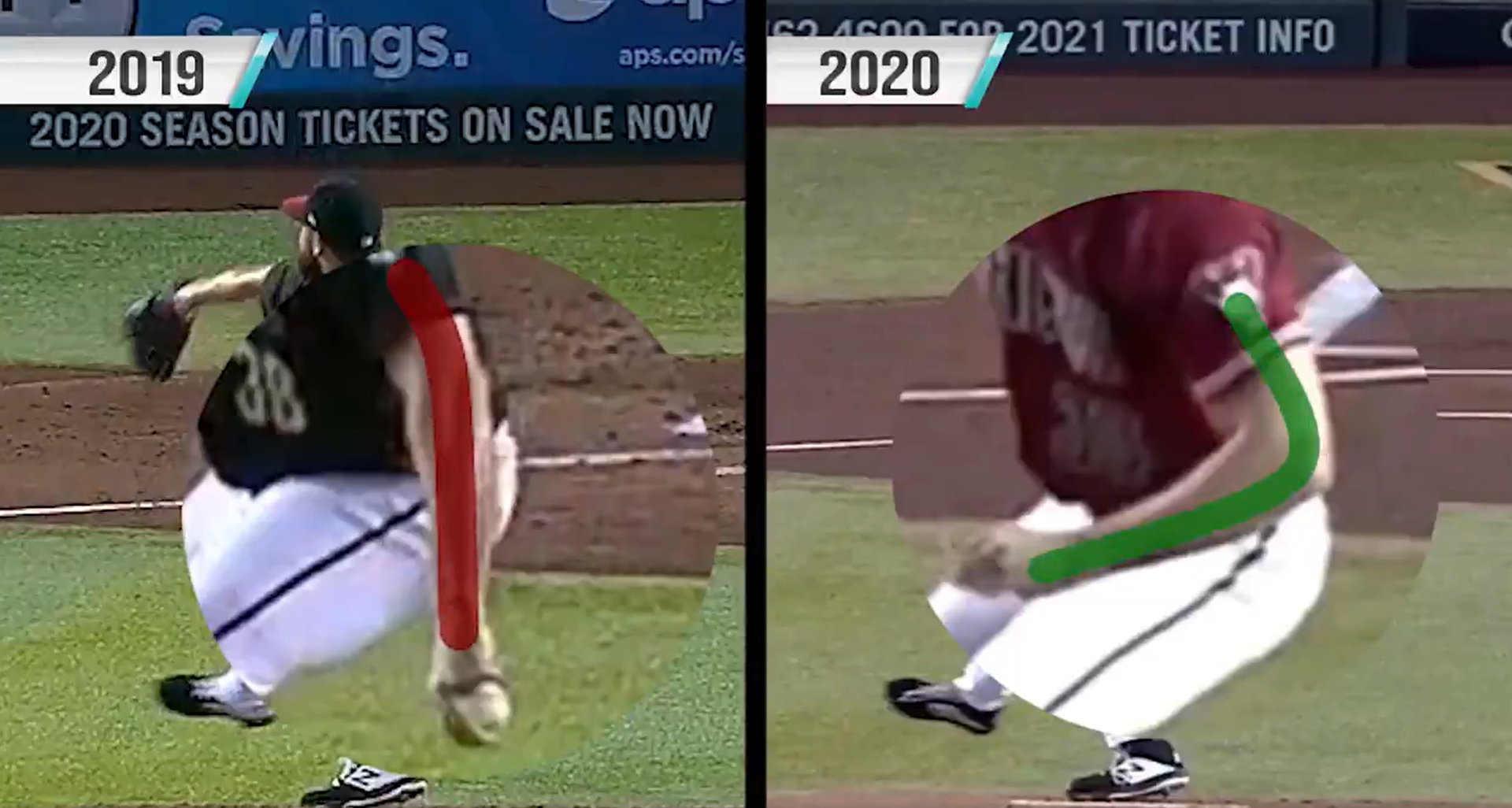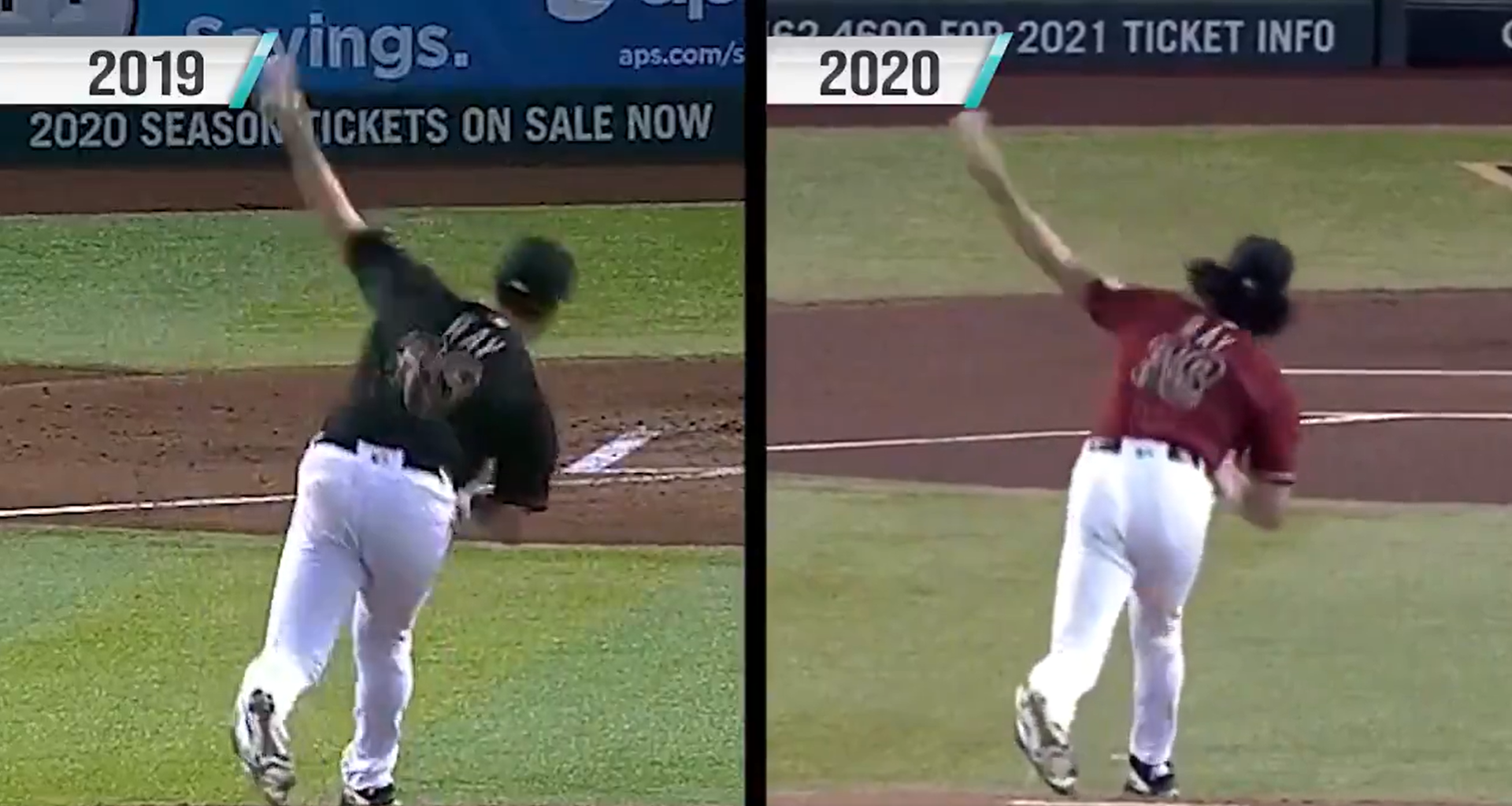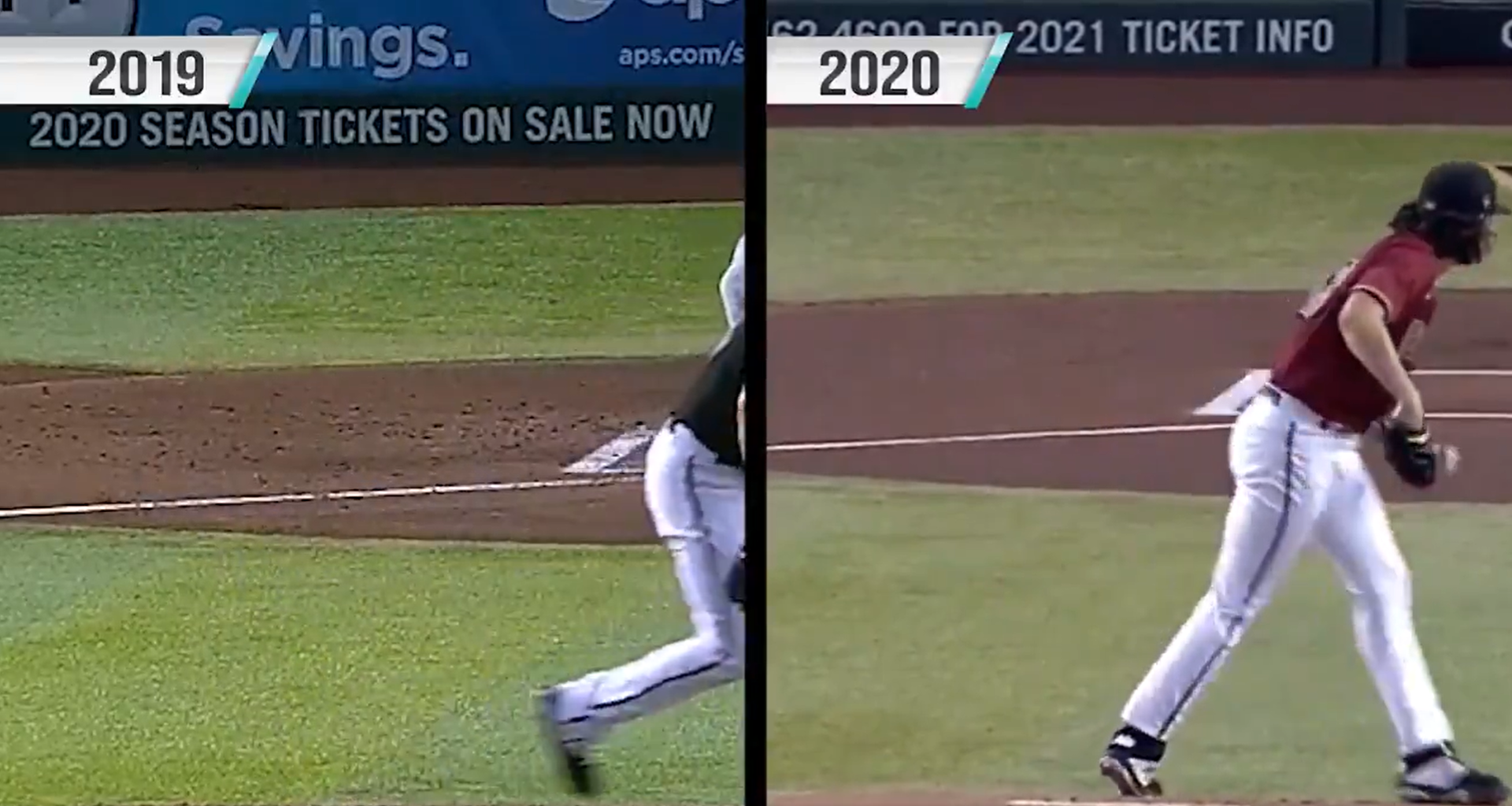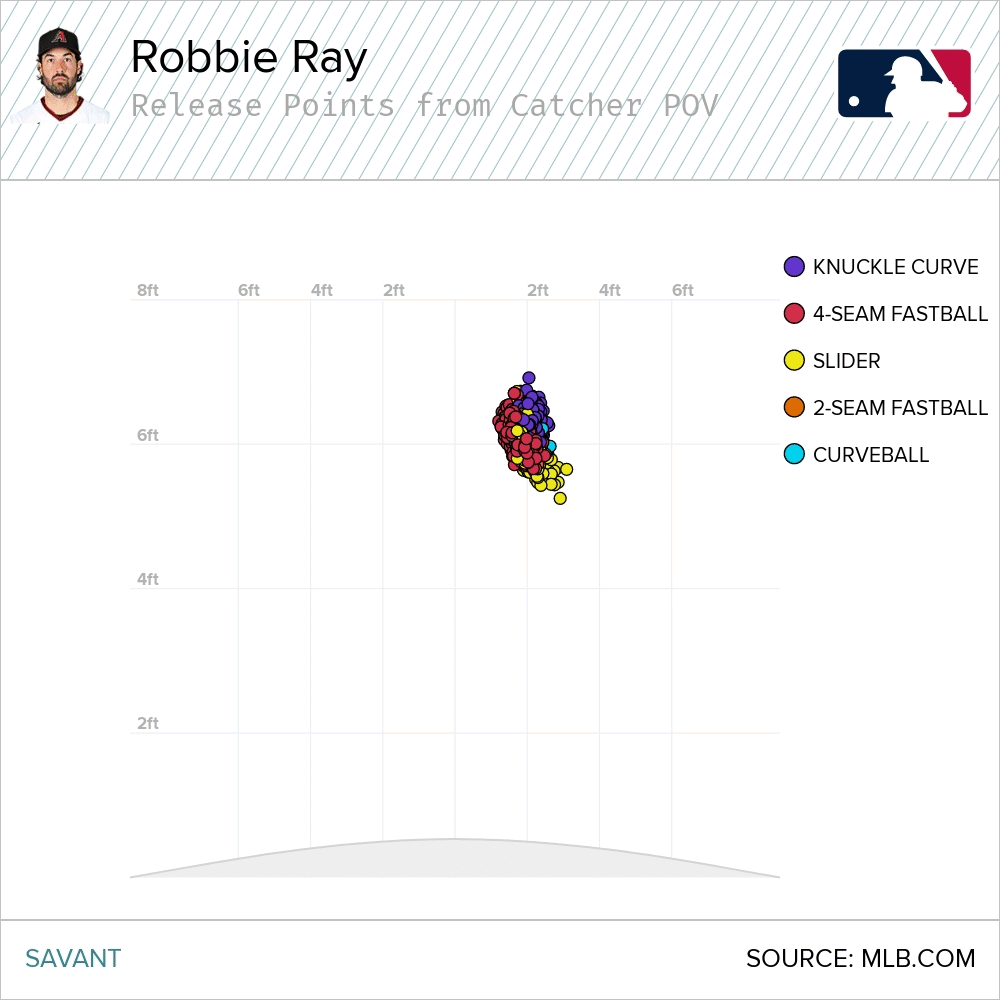For how many hitters Robbie Ray strikes out, he’s been awfully frustrating over the years. He has one of the more considerable walk problems in baseball, and he gives up more home runs than is ideal too. Given that these three variables make up the components of FIP and xFIP, it’s perhaps not surprising that he comes up as every so slightly above league-average over his career. And these don’t even account for the fact that he gets hit hard, either. Well now, Ray has come into spring training and summer camp with a new look.
Of course, some of that is literal. Ray has shed some weight with a new, dairy-free diet, his beard is gone, and in its stead is a longer mane of hair under his ballcap. But those things are more or less insubstantial. I want to know what’s changed on the mound.
I’m not sure how it took me so long to be alerted to this, because this change has existed since spring training, but here’s a tweet from Lance Brozdowski that set off the alarm bells for me:
Lot of buzz around Robbie Ray these last few days. His arm-action change is pretty substantial. Sky is the limit if his walks come down.
Also noticed his momentum towards home plate is direct. Still a 3B side fall-off but more controlled. #DBacks pic.twitter.com/p3pVB7KRz0
— Lance Brozdowski (@LanceBroz) July 19, 2020
And, to make it as easy as possible, I’m going to hit you with a barrage of screenshots. We should come out on the other side with a different understanding—and hopefully appreciation—of Ray.
First, his actual windup, with 2019 on the left and 2020 on the right:

Ray is starting his windup with a significantly smaller step, and he’s also going over his head now. Already, he’s looking much more controlled.
Next, Ray has shortened up his arm circle:
This is going to get all of the attention—and for good reason! You can see here that in 2019, Ray extended his arm straight out, whereas he’s tucking it in more in 2020, as if he’s going to throw a football. This is the change Lucas Giolito made that predated his breakout, and also something that pitchers like Joe Kelly and my beloved Shane Bieber have made. Theoretically, this might give him an added tick or so on his fastball—and reports are that it is—but it should help with the repeatability of his delivery as well.
Ray’s arm slot deserves consideration:

It’s not the easiest thing to eyeball—especially when the angles are different. But it seems that Ray has lowered his arm slot. On the left, you can see Ray with a heavy lean to his right as he gets the ball high over his head. He ranked in the 78th percentile in vertical release point in 2019. On the right, though, it looks like his arm has dropped down, which has helped his shoulders and hips be more square to the plate, and his body more postured up in general. Given his posture in either picture, this is likely to have a positive effect on his command. It looks more comfortable for him, and this lowering in arm slot is the type of change that we’ve seen produce improvements in pitchers like James Paxton. I haven’t heard from Ray himself, but I wouldn’t be surprised if he found this new arm slot to be more natural for him.
But also, lowering his arm slot is likely going to change the way his pitches move. Given his previous arm slot, he gets a lot of north-south movement on his breaking pitches. His curveball gets little horizontal movement, and his slider even fewer. He’s set up for a north-south approach (i.e., the Blake Snell blueprint; fastballs up, secondaries down), and for the most part, that’s what he’s done. So, long story short, his pitches should see a touch more horizontal movement moving forward.
And lastly, Ray’s finish:

On the left, you can see that Ray’s delivery has whipped him over towards the third-base side, out of the frame. Now, in 2020, he’s finishing in a more controllable fashion, a little more nimbly.
With this in mind, let’s compare Ray’s 2019 arm slot to Patrick Corbin, who throws out of a similar slot:

Corbin has what I would describe as above-average command, and that’s due in part because of his ability to repeat his delivery. Ray’s command I would describe as, well, not good. With a more repeatable delivery will likely come a more repeatable arm slot; and improved command should follow. While a boost in velocity would be nice (and is perhaps likely), the development of his command is what we really want to gain from this.
For Ray, this couldn’t have come at a better time, as he’s been hemorrhaging fastball velocity since 2017, but especially in the second half of 2019. We can’t say with certainty that this is going to improve his fastball velocity or command, but it feels intuitive. His new delivery speaks to increased controllability and repeatability, which should address command, but it could also aid his velocity—shortened arm action notwithstanding.
I was watching a few clips of Ray that I happened upon, and a few things stuck out. Take a look at this slider:
https://gfycat.com/uncommonamazingkid
That slider came in at 87 mph. Usually, that’s where Ray is topping out at. But now, he might be sitting there.
And then there’s his curveball:
https://gfycat.com/slipperyscarcebrontosaurus
This one comes in at 85 mph. Again, Ray was sitting at 80 mph with his deuce last year while maxing out at 85. That’s a huge step up.
If this is legitimate, this is a big development. Of course, the guns could very well be hot. It’s not unfeasible to think that they’re just not calibrated yet. And so, until his first start of the regular season, we can’t know what Ray will look like. But also:
.@RobbieRay at #DbacksSummerCamp:
11 IP
1 H
17 K pic.twitter.com/YQGivJDsc9— Arizona Diamondbacks (@Dbacks) July 16, 2020
Now, it’s summer camp, but that’s a 13.91 K/9 with a 2.45 BB/9 and only one home run over those 11 innings. It’s a painfully small sample size, against a rather niche group of players. We can’t put too much weight into it, but it’s notable that his numbers are this good when his career spring training numbers are a 10.64 K/9, 4.59 BB/9, and a 1.47 HR/9.
As a parting note, I wish that Ray would switch out his slider for his curveball. It seems like a more controllable pitch for him, and not only does it go for significantly more called strikes, but it doesn’t lag far behind in swinging-strike percentage (thus, a much higher CSW). It seems intuitive to go with a pitch that’s a better strike-getter and is better at suppressing hard contact. Maybe it’s a feel thing, or maybe it’s a head thing, but if Ray could make that swap and do a better job of placing both below the zone (as opposed to his arm-side or glove-side), he could have already been better than he’s been.
I don’t want to come out and say that Ray has remade himself as pitcher, because we don’t know that yet for certain. But we have before us a considerable change that we could look back at after 2020 and think that it was pretty apparent that Ray was going to change for the better—and rather significantly. To me, it’s obvious that he has skills to be a premier starting pitcher (or something just short of it). And he probably always has. But now, with a judicious mechanical adjustment, Ray could be headed for the breakout that Giolito has already undergone. I’ll stop short of saying that it’ll happen, but it’s in the cards. These are the types of things that make you love pitching.
Photo by Adam Bow/Icon Sportswire | Adapted by Justin Paradis (@freshmeatcomm on Twitter)

